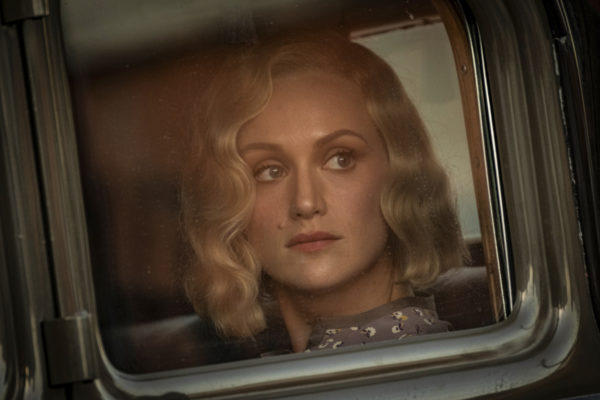
Each week, Joe (@bstolemyremote) and Terry (@gaylydreadful) review an episode of Showtime’s Penny Dreadful: City of Angels, alternating between our respective sites — queerhorrormovies.com and gaylydreadful.com.
Spoilers for episode two…
1.02 “Dead People Lie Down”: Raul Vega lies on the brink of death. Tiago and Lewis meet radio evangelist Sister Molly Finnister. Councilman Townsend furthers his political goals. Peter Craft runs into Elsa at the beach.
Missed a Recap? Episode 1
JOE
In our discussion about the premiere last week, Terry, we debated the decision to lead with a single episode. With the luxury of having seen the second episode, you reassured me that a double bill would have been advisable, and – having now seen “Dead People Lie Down” – I’m inclined to agree with you.
It’s not that this is a stronger episode per se, but it certainly works to complement that dense introductory episode, which mostly expended its energy introducing the vast myriad of characters. Here, there’s an almost noticeable effort to let scenes (and therefore characters) breathe.
The person who benefits most is Detective Tiago Vega (Daniel Zovatto). While I still don’t have the same kind of interest or affection in Tiago as I do with some of the other characters (blame protagonist syndrome), his meet cute with new character Sister Molly (Kerry Bishé) went a long way. It not only enables us to see him in a different environment, but also forced out of his two prominent communities – his Mexican home life and his police work – which automatically offers fresh insight into his background.
Zovatto and Bishé’s extended scenes, where he chats with the former child star turned religious money maker and they relate their experiences with both religion and death, are simultaneously wholesome and subtly romantic. There’s clearly more than a cursory interest here, with hints of a star-crossed lovers-in-the-making. They’re delightful, particularly in an episode that’s otherwise brimming with turmoil, conflict and duplicitous behaviour.
The other reason that I much preferred “Dead People Lie Down” is because it’s a more grounded hour that’s focused on its human characters. “Santa Muetre” was bookended by a pair of scenes that suggested humans are nothing more than puppets for the gods and their whims. This, by contrast, is an hour that only has one moment of divine intervention: the finale when Maria (Adriana Barraza)’s prayer to Santa Meutre (Lorenza Izzo) to save Raul (Adam Rodriguez)’s life is answered in a chilling night time hospital scene.
The result ensures that the audience is more keenly aware of who the focus of the series is (the humans, not the vengeful sister gods). It also makes that final scene all the more effective because it is so starkly different from everything else. It’s City of Angels’ first true moment of horror and it plays extremely well (my husband jumped when Raul appeared in front of Maria and, sure, he doesn’t do horror, but that jump scare is also legitimately well staged).
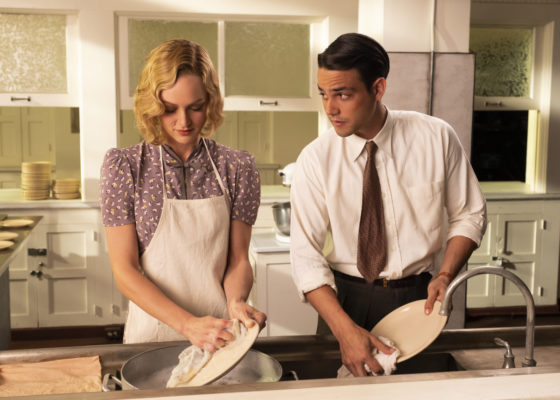
But I’m jumping around. The meat and potatoes of the episode is this: in the aftermath of the shooting, Los Angeles is more on edge than ever before. As Alex (Natalie Dormer) goes to work encouraging Council Townsend (Michael Gladis) to use recent events to bolster his political position, Detectives Vega and Lewis (Nathan Lane) dig into the past of James Hazlett, the man whose body was found in the aqueduct in the premiere. The investigation leads to the extremely profitable Joyful Voices Ministry, where Sister Molly speaks and sings to sold out crowds, the hungry are fed and Molly’s mother Miss Adelaide (Amy Madigan) maintains rigid and evasive control over everything. It’s pretty clear that something shifty is going on with the church, whose acceptance in the community is presented in stark contrast to both the secluded Mexican record store where the Vega family work and dance and the Nazi demonstration in the park.
Penny Dreadful creator John Logan, who penned this second episode, isn’t subtle about highlighting how people are treated differently when their skin is dark compared to pale. As likeable as Sister Molly is, her pale skin and perfectly blonde hair clearly denotes a life that’s a far cry from the racism that Tiago and his family have experiences. She may have crises of faith and she may be getting abused by her mother, but the freedoms and privileges Molly claims most certainly include not getting spit on or having an eyeball nearly gouged out by by policemen.
Terry, I’ll turn it over to you to fill in the other blanks. Were you surprised to see Lin Shaye (!) pop up as Dottie, Lewis’ Jewish stake-out friend? Are you frustrated that in two episodes Townsend remains little more than a caricature of a familiar politician? And would you like to take a first stab at the importance of the two films that dominate the episode: Gone with the Wind and Beau Geste?
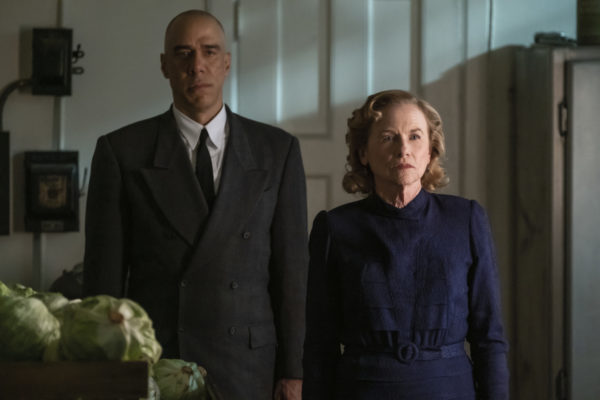
TERRY
The way the ending scene was staged was fantastic, Joe. I completely agree. I also enjoyed the symmetry between the episode two reveal that Raul is alive/undead with the episode two reveal in the original series that Frankenstein’s original creation was still alive/undead. I’m curious if we will continue to see little throwbacks to Penny Dreadful.
But onto your questions, I have to say, when Lin Shaye showed up on screen, I stared at her, thinking, “she looks so familiar…” A little later, the framing was closer, I realized who she was and…well, this is what I wrote:
“LIN SHAYE!!!! DOTTIE!!! WHTFASLDFJ”
So, no, Joe. I absolutely was not surprised to see her. Hah. But seriously, Lin Shaye! Robert Kind as Sam Bloom (RIP, Sam)! I honestly loved the introduction of Lewis’ little group of Nazi-hunting Jews. I particularly chuckled at the line, “So a bunch of old Jews are going to stop the rise of the third reich.” What I like about these characters and Lewis’s nightly activities is that their plight and the plight of the Jewish people is juxtaposed with Lewis’ own casual (or worse?) racism towards Vega and the Chicanos of LA.
Of course, our intrepid hunters split up to follow two separate leads, which, er, leads to Sam and Anton (Bill Smitrovich)’s death. I do hope we see more of Lin Shaye’s Dottie, though, if only to hear Nathan Lane tell her to, “turn up your ears!” again.
So, Joe, my biggest complaint about the show so far (and, honestly, a lot of shows right now) is a lack of subtlety, as you brought up. Someone is going to eventually write a think piece about how entertainment post-2016 has the subtlety of a brick to the face. Maybe it is the fact we live in such a bizarro world right now, but I’ve noticed a trend of GOOD and EVIL, with little room for nuance in how broadly characters are being written.
Which brings me to Townsend.
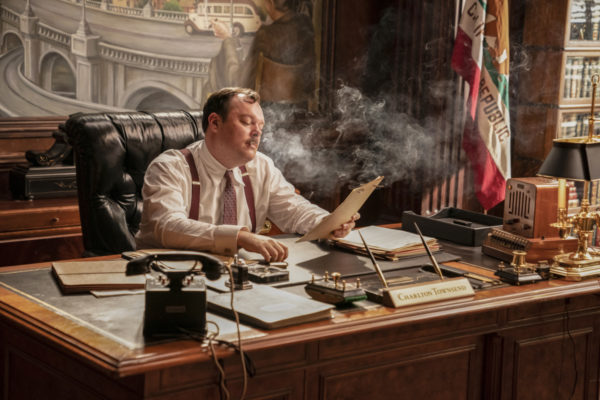
On one hand, I do like the idea of some little devil perched on his shoulder, poking him and guiding him down his more base desires. But on the other, I’m afraid in an episode or two his moustache is just going to twirl right off his face. He’s just so campily and theatrically evil that I expect him to kidnap Tiago’s mom Maria and tie her to some train tracks next episode. The way he goes from “we can’t exploit a bunch of dead cops for politics” to, a couple scenes later, “the animals that assassinated…” would be comical if it weren’t about issues that are still pertinent today.
I guess this leads to the one thing that has been bothering me from the beginning: the whole concept of Magda (Natalie Dormer). Her presence has left me with an icky feeling…and not a horror icky feeling. It’s the icky feeling that uncomfortably asserts that some evil being might end up being more complicit in both Townsend and Dr. Craft (Rory Kinnear)’s evil deeds than the men doing it. Does the fact that we have a literal devil whispering in their ears ease their culpability? I ask because Magda isn’t a figurative thing, but a literal demon literally and figuratively sowing destruction in her wake.
In “Santa Muerte,” we’re introduced to Magda’s, for lack of a better word, thesis on humanity: “All mankind needs to be the monster is being told he can.” Which, okay. True, if nihilistic. But then the way she “tells” mankind feels more in the way of mind-controlling them into puppets and less the snake slithering in their ears. Does that make sense?
That’s where I start to feel icky.
I’m hopeful John Logan plans to do something interesting with this dynamic and not simply use it as some supernatural set dressing. One of the things I’m guilty of while watching shows week to week is to make assumptions that the show eventually counteracts, so hopefully this is one.
You also obliquely referenced one of the more potentially interesting, if vaguely West Side Story caricature, introduction of Fly Rico (Sebastian Chacon), who interrupts racist cop Reilly (Rod McLachlan) from trying to gouge out Mateo (Johnathan Nieves)’s eyes. I say “potentially interesting” because the chemistry between the slightly androngenous (yet masculine, if that’s possible?) Rico and Mateo is…intense. I wrote in my notes, “Rico is eye-fucking Mateo” and he even invites Mateo to find him at The Cat because he didn’t scream…baby. I’m curious to see where this storyline leads, particularly because there has been a dearth of queerness in this show.
You asked me about the importance of Gone of the Wind and Beau Geste in this episode and I’m just going to admit I’ve never seen either of them, so I’ll kick that back to you, Joe. I’m also curious what you thought of the beach scene with Elsa (also Natalie Dormer), Dr. Craft and his boys, one of which seems to suspect that something ain’t right with Elsa’s son Frank (Santino Barnard). And are you at all interested, right now, in the noir-tinged murder mystery involving the Hazlets?
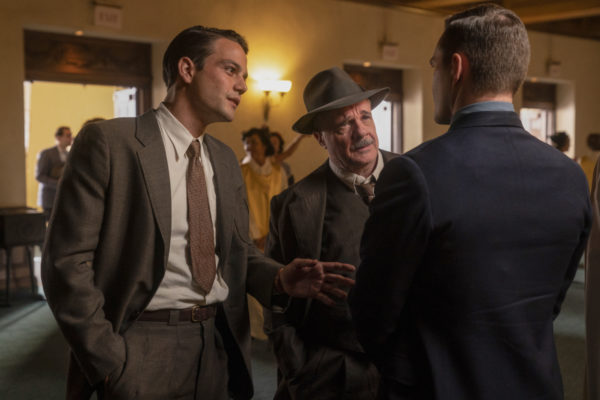
JOE
Oh there was absolutely eye fucking going on between Fly Rico and Mateo. I mean…that name alone!
Now, the references to two films are definitely not coincidental, though it’s always tricky to decide how far down the rabbit hole to go. Part of me is tempted to do a deep dive into the lore surrounding the potential casting of Bette Davis in Gone With The Wind, though I think the references to that film are more about taking the cultural temperature of the time. Lest we forget: Gone With The Wind was an incredibly successful book that went on to become an incredibly successful movie, so the fact that both the Nazis and the Jews are talking about the same thing could merely suggest that everyone was in agreement about what the “big thing” was at the time.
Of course, it’s one thing to simply write-off the debate about Davis’ age appropriateness as an amusing side conversation, but this would ignore the fact that we’re talking about a series where nearly every character is test-driving the suitability of their role. Tiago is torn between his family history and his career-defining job; Molly wants to heal the world but she knowingly works for a crooked organization; and Lewis enables racism at work, but covertly hunts Nazis at night, etc. The idea of “the right fit” could easily apply to the characters’ path to discovery about where they fit in the world and what role they’ll play in the drama to come.
1939’s Beau Geste is similarly significant (caveat: this is me spitballing since I haven’t seen it). As Lewis explains to Tiago, there is a central conflict that requires the placement of corpses around the perimeter of a fort to fool the “Arab” villains (ahh racism). Broadly speaking, however, the plan requires the cooperation of people who were previously at odds with each other: two brothers who spend the movie being abused by their tyrannical supervisor, Sergeant Markoff. It is only when Markoff and the brothers “throw aside their rivalries” and band together that they can overcome a larger, more deadly enemy.
Taken as such, Beau Geste offers us a road map of the season to come (again, with a disappointing lack of subtlety). It’s not exactly surprising that the series will build towards the characters forming an alliance since this is more or less the same structure as the original incarnation of Penny Dreadful.
If Beau Geste truly is a blueprint, it begs the question: who will come together and who is the Big Bad? My guess is Tiago, Molly and Lewis, possibly with the unexpected help of Peter, to go up against the more covert Nazis (in my fantasy, Townsend is shuffled to the side quickly and with minimal fuss). Or maybe they have to band together against Magda and Santa Meutre to wrangle back control of their own lives?
Either way, like you Terry, I’m definitely concerned about the way that villains are seemingly controlled by larger forces. Thus far the characters falling prey to Magda are all lower case villains – Townsend is clearly a moron, Raul came across as a hothead and Dr. Craft is prone to using his little brain below the belt (as confirmed by his icky sex fantasy). Is it better or worse that City of Angels seems to be suggesting that all men are easily manipulated? Perhaps in time we’ll find out that it’s only “weak” men. We’ll have to wait to see what happens when someone with moral authority like Tiago or Molly go up against Magda.
So that leaves poor sexually dissatisfied Peter and his boys at the beach. Aside from the now uncomfortable visual of a crowded beach (I’m not ready to forgive Florida or California!), my big take-away from this scene is that kids, and more specifically Tom (adorable Julian Hilliard from The Haunting of Hill House), are far more aware of weird shit. Thus far all of the adults on the show, save Maria, have had zero awareness of what is actually happening around them. Call it children’s intuition, or the fact that Frank is fucking creepy, but Tom is absolutely clued in. Unfortunately that likely puts him in danger since what Frank knows, Elsa likely also knows and she doesn’t seem like someone who is afraid to harm a child.
Now my big question, Terry: considering the transition from Elsa to Alex, should we infer that all of Dormer’s characters are one and the same? Do you think Raul is now some kind of zombie? And since I completely avoided your question about the noir crimes, what is your hypothesis about who’s behind Hazlet’s death? It’s got to be Molly’s mom, right?
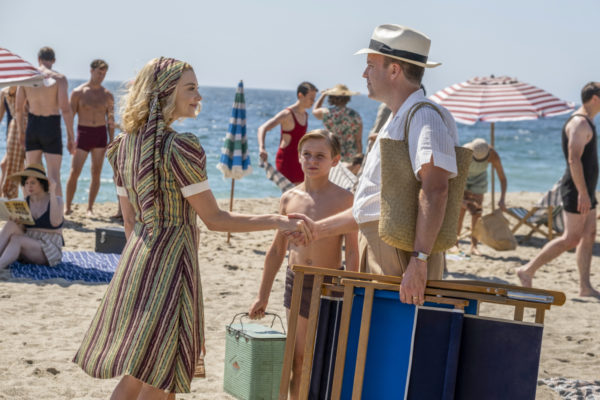
TERRY
Let me grab my fedora and bottle of whiskey and say that, in true noir fashion, the murderous conspiracy goes all the way to the top! What top, you may ask, Joe? The top, top!
Molly’s mom absolutely has something to do with it. But I’m willing to bet it ties religion and government and police all together. There’s a reason Chief Vanderhoff (have we even mentioned he’s played by Brent “Data” Spiner?) wants them to “conclude” rather than “solve” the mystery by offering up any Chicano. There’s a reason Hazlet worked at the church and was working on the new highway…a highway that Richard Goss (Thomas Kretschmann), noted Nazi and wannabe-friend to Townsend, wants to build.
As I see it, the plan is simple: blame the Chicanos who want their homes safe by bringing in mysticism and ritualistic murder in order to hide the fact that Nazis have either infiltrated or have their fingers in every facet of LA.
The top, I say!
As for the more supernatural elements of the show, Magda is absolutely changing shape to Elsa and Alex (which is confirmed in the teaser for next week’s episode). When Elsa is introduced in episode one and then later Society’s Frank into her stomach, I knew that they were one and the same. Combined with her assessment at the beginning of the season that all mankind needs is to be told to be evil, they have to all be one and the same. She has created versions of humans that are perfectly capable of bending specific men to her.
Take Elsa and Dr. Craft. A known Nazi with troubles at home, including a brunette wife (Piper Perabo) who drinks, he meets a gorgeous German woman who appears demure but also has that Nazi-prized blonde hair. And then this version of Magda further instigates Dr. Craft’s predilections by making up a story about her abusive Jewish husband. Puddy in her hands. Alex, meanwhile, is a whip smart and always professional assistant to Townsend, offering up helpful insights and coming up with plans, but always allowing the man to get the credit.
Which leads us to Raul. I’m really curious to see more of his state in the next episode. I’m willing to bet he’s some sort of undead. The parallels to the original Penny Dreadful are too juicy to pass up. I’m also wondering, to jump off your point about the different sides coming together, what role this new, presumably pissed off, Raul will take. Especially since it was his brother who shot him…
Hopefully we’ll learn more next week when we go back to Gayly Dreadful for episode 3 “Wicked Old World.”